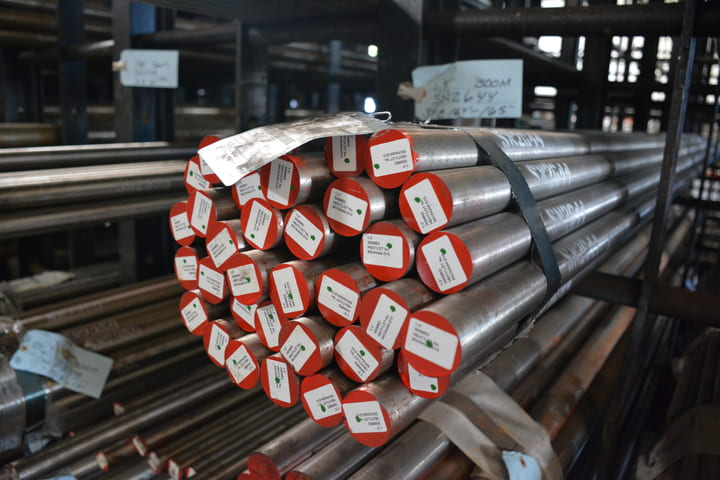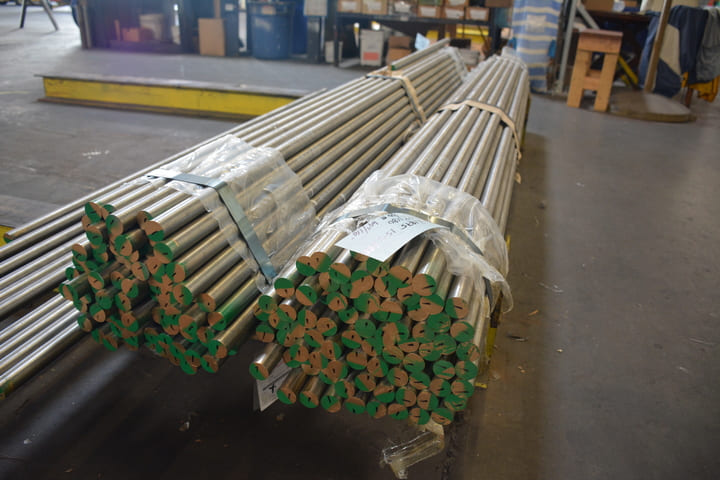9310 Alloy Steel
9310, a low-alloy steel, is renowned for its high strength, toughness, and resistance against stress and wear. This metal is regularly employed in the aerospace and defense industries in numerous applications such as bearings, gears and shafts. 9310 grade of steel, can be further enhanced with a process called heat-treating – increasing its hardness and toughness. This particular metal is most commonly found in bars, forgings, or tubes of various dimensions adapted to fit specific requirements.
Friend Metals Distributor offers the highest caliber of 9310 alloy steel to suit a variety of industrial purposes. Our Experts Await! Reach us at 714-632-0140 or Toll-Free 800-854-6777!

9310 Forging
9310 is ideal steel for forging, as its excellent mechanical properties, high strength and outstanding toughness guarantee optimal performance in aerospace and defense applications. Furthermore, the forging process can boost the material’s dimensions accuracy, strength and resilience on top of these features. This makes it a premier option when seeking high-grade components.
The craft of forming metal through the use of pressure is known as Forging. This is accomplished by either a hammer or a press being applied to it, and there are different approaches that can be used such as open-die or closed-die. Both have their own benefits for achieving desired results.
When it comes to forging, there are two methods employed – the first of which is called ‘array-die’. This process involves taking a material and forming it by squeezing between two flat dies. It is most suitable for producing large forgings with intricate shapes. The second technique, known as ‘closed-die’ or ‘impression’, takes place within a special cavity; this procedure is best for creating intricate items that require precision in their construction.
When trying to create a specific shape and size of the final product, 9310 steel can be effectively forged using either of two methods. The most important part of the process is heating the metal up to a temperature that will make it easier to work with; this temperature must be above its recrystallization point.
To produce a desired form, size, and properties of an object, a forging press or hammer is utilized to apply pressure onto a heated material. This process can be replicated multiple times in order to get desired shape.
In order to guarantee the desired level of dimensional stability and quality, the material that has been through the process of forging usually needs to be heat-treated. During this treatment, it is heated up to a particular temperature before being cooled promptly. This method helps attain an ideal microstructure and mechanical properties.
Do you need 9310 forgings for aerospace or defense applications? Our top-grade forgings are designed to meet the exacting standards of these sectors and we have them in a range of shapes and sizes to suit your particular requirements. Reach out to us today and find out more about our forging solutions.

9310 Bar
9310, an example of low-alloy steel, is widely employed across the aerospace, automotive and defense industries for its remarkable characteristics. This particular steel is highly appreciated due to its high hardenability, strength and toughness; resulting from a combination of nickel, chromium and molybdenum elements. Furthermore, it has excellent fatigue properties as well as resistance to corrosion and wear.
9310 alloy can be found in the form of bars, commonly used to make performance-based components, like gears, shafts, as well as bearings. Hot rolling or cold drawing procedures are implemented depending on the required size and design of the ultimate product.
Rather than heating the material, with cold drawing it is passed through a die in order to acquire the desired size and shape. This process can be repeated various times to obtain the necessary properties and measurements. In comparison, during a process known as ‘Hoss Rolling’, temperatures are raised above their recrystallization point before passing them through rollers so that their thickness is reduced and they are subsequently shaped into bars.
9310 bars crafted from stainless steel come in a variety of shapes and sizes, like circular, square and hexagonal. This material can be heat-treated to refine its mechanical properties for example hardness, strength and endurance. Through quenching and tempering the metal is heated up to a certain temperature before cooling it quickly with something such as oil or water. It’s then reheated at a reduced temperature and held for an exact amount of time to acquire the desired properties.
The aerospace and defense industries require products of the highest quality, which is exactly what we offer with 9310 bars. We also offer 9310 alloy in a variety of shapes and sizes, these bars can be tailored to suit exact specifications for each individual customer. Get in touch with us now to find out more about the high-grade alloy steel 9310 bars that we offer.

AMS 6265
The Society of Automotive Engineers (SAE) has established a standard known as AMS 6265 for heat treating 9310 alloy. It is a suitable choice for the use in high-stress situations.
The AMS 6265 specification outlines the testing standards for material quality. This includes hardness testing, impact testing, and ultrasonic testing – all of which are used in order guarantee that the material possesses appropriate mechanical characteristics and is free from any flaws that could hinder its performance or dependability.
Friend Metals offers a vast selection of alloy steel bars and forgings with precision-crafted details that adhere to the quality standards set by AMS 6265 and other industry specifications.
9310 Alloy Chemical Composition
9310 alloy contains a combination of alloying elements, including chromium, nickel, and molybdenum. The chemical composition of 9310 steel is as follows:
- Carbon (C): 0.08 – 0.13%
- Silicon (Si): 0.20 – 0.35%
- Manganese (Mn): 0.45 – 0.65%
- Phosphorus (P): 0.025% max
- Sulfur (S): 0.025% max
- Chromium (Cr): 0.80 – 1.00%
- Nickel (Ni): 1.00 – 1.50%
- Molybdenum (Mo): 0.20 – 0.30%
9310 Alloy Mechanical Properties
9310 alloy offers excellent mechanical properties, including high strength, toughness, and wear resistance. The following are the typical mechanical properties of 9310 steel:
- Tensile strength: 220 – 250 ksi
- Yield strength: 180 – 200 ksi
- Elongation: 8 – 12%
- Reduction of area: 40 – 50%
- Hardness: 248 – 302 HB
